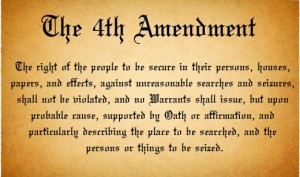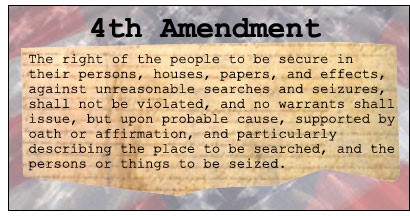When are the police authorized to seize your property: When does probable cause exist?
People v. Sanders
2016 NY Slip Op 01255
New York Court Of Appeals
Decided on: February 23, 2016
Click for more on Criminal Appeals Law In New York
 Issue: Whether a Defendants Fourth Amendment right against unreasonable searches and seizure was violated when Police took Defendants clothing, which had been placed in a clear hospital bag in plain view, without a warrant or his consent while Defendant was dressed in hospital clothes in a nearby room.
Issue: Whether a Defendants Fourth Amendment right against unreasonable searches and seizure was violated when Police took Defendants clothing, which had been placed in a clear hospital bag in plain view, without a warrant or his consent while Defendant was dressed in hospital clothes in a nearby room.
Holding: The seizure was unconstitutional, and the defendants motion to suppress physical evidence should have been granted. The Court of Appeals held that, under the plain view doctrine, if the sight of an object gives the police probable cause to believe that it is the instrumentality of the crime, the object may be seized without a warrant if three conditions are met: 1) the police are lawfully in the position from which the object is viewed; 2) the police have lawful access to the object; and 3) the objects incriminating nature is immediately apparent (People v Brown, 96 NY2d, 80, 89 [2001]).The Court of Appeals held that the hearing court erred in denying Defendants motion to suppress the clothing seized by police. The Court found that the hearing evidence did not show that the office knew that the entry and exit wounds were locatd on an area of defendants body that would have been covered by the clothes defendant wore at the time of the shooting or that the shooting had affected the defendants clothes in any way. Thus, there was no probable cause to believe that the clothing was the instrumentality of a crime.
 Facts: Defendant walked into Jamaica Hospital seeking treatment for a gunshot wound and the hospital reported the shooting to police. By the time the defendant spoke to the officers, he was wearing hospital clothing and his clothes were placed in a clear plastic bag that rested on the floor a short distance away from defendants stretcher. Police seized the bag and inspected each garment. Defendant was subsequently charged with criminal possession of a weapon. Before trial, Defendant sought suppression of the clothes based on unlawful warrantless seizure of those items. The People opposed, stating that police can seize evidence where the items are in open view and the officer observed them from a lawful vantage point. Supreme Court denied suppression and Defendant appealed to the Appellate Division. The Appellate Division affirmed the judgment stating since the Defendants clothing was lying on the floor of a hospital room in a clear plastic bag, the clothing was openly visible and that the police had probable cause to seize the clothing as evidence of a crime of which they believed the Defendant had been a victim. A judge of this court granted Defendant leave the appeal and the Court of Appeals reversed.
Facts: Defendant walked into Jamaica Hospital seeking treatment for a gunshot wound and the hospital reported the shooting to police. By the time the defendant spoke to the officers, he was wearing hospital clothing and his clothes were placed in a clear plastic bag that rested on the floor a short distance away from defendants stretcher. Police seized the bag and inspected each garment. Defendant was subsequently charged with criminal possession of a weapon. Before trial, Defendant sought suppression of the clothes based on unlawful warrantless seizure of those items. The People opposed, stating that police can seize evidence where the items are in open view and the officer observed them from a lawful vantage point. Supreme Court denied suppression and Defendant appealed to the Appellate Division. The Appellate Division affirmed the judgment stating since the Defendants clothing was lying on the floor of a hospital room in a clear plastic bag, the clothing was openly visible and that the police had probable cause to seize the clothing as evidence of a crime of which they believed the Defendant had been a victim. A judge of this court granted Defendant leave the appeal and the Court of Appeals reversed.
 Legal Analysis: The Court of Appeals held that the hearing court erred in denying defendants motion to suppress the clothes by the police. There was no record support for lower courts conclusion that the investigating officer had probable cause to believe that Defendants clothes were the instrumentality of a crime. Defendant awaited treatment at the hospital while dressed in different clothes from those he wore at the time of the shooting. The evidence presented at the suppression hearing does not show that, before the seizure, the testifying officer knew that entry and exit wounds were located on an area of Defendants body that would had been covered by the clothes Defendant was wearing at the time of the shooting.. The Court reversed the order of the Appellate Division to suppress the physical evidence and vacated the judgment.
Legal Analysis: The Court of Appeals held that the hearing court erred in denying defendants motion to suppress the clothes by the police. There was no record support for lower courts conclusion that the investigating officer had probable cause to believe that Defendants clothes were the instrumentality of a crime. Defendant awaited treatment at the hospital while dressed in different clothes from those he wore at the time of the shooting. The evidence presented at the suppression hearing does not show that, before the seizure, the testifying officer knew that entry and exit wounds were located on an area of Defendants body that would had been covered by the clothes Defendant was wearing at the time of the shooting.. The Court reversed the order of the Appellate Division to suppress the physical evidence and vacated the judgment.
